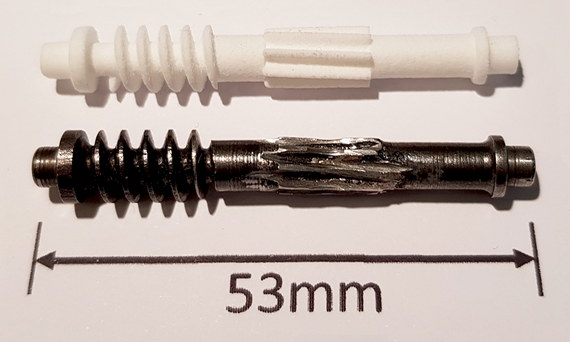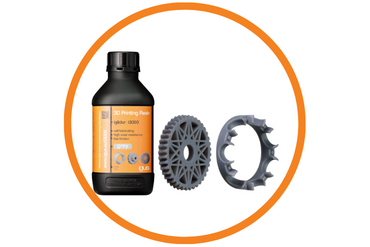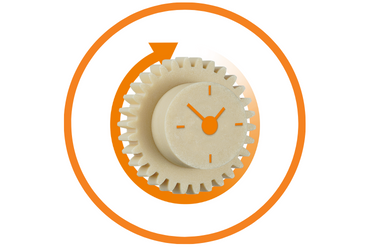3D printed spare parts for vintage cars
Finding spare parts for vintage cars is usually difficult, if not impossible The procurement of spare parts is a known problem, especially for exotic vehicles and rare models. Some of the parts that need replacing can be decades old and can have significant wear. All of this usually means expensive. However, this is not the case if you consider using materials such as the abrasion resistant iglidur® i6 SLS polymer and 3D print the part you need.
Would you like more information about the igus® 3D printed service or range of materials? Or do you need an individual consultation? Our experts will be happy to get in touch with you.
To the 3D printing service
Would you like more information about the igus® 3D printed service or range of materials? Or do you need an individual consultation? Our experts will be happy to get in touch with you.
To the 3D printing service
Contact the expert
Problem
In the Stewart Warner speedometer, the gear on the first intermediate shaft which meshes with the worm on the input shaft was no longer in working order. The pinion was no longer engaging with the worm gear. Due to the work done on the speedometer by the previous owner, it was impossible to determine the correct dimensions. The manufacture of a spare part required several attempts and a material that was stable, enabled high precision and was suitable for continuous use.- What was needed: replacement worm gear in the speedometer of a vintage car
- Manufacturing method: selective laser sintering with SLS powder
- Requirements: durability, precision, low price
Solution
With the igus® 3D printing service, a fully functioning spare part was made from iglidur® I6. Due to fast and cost-effective manufacture with the laser sintering method, it was a straightforward for the vintage car owner to test several variants of the component in practice. The high-performance polymer used with incorporated solid lubricants ensures the component no longer needs to be lubricated. Even after being in use for more than 2,000 miles, no signs of wear are detectable.- Material: iglidur® I6
- Industry: automotive sector
- Success for the customer: excellent precision, no abrasion, fast and cost-effective manufacture, no lubrication
What caused the worm gear in the speedometer to become worn?
The speedometer of a Stanley 750B vintage car built in 1924 no longer functioned - the mileage counter was defective. The cause of the defect was found by the owner to be the toothed gear that was located on the first intermediate shaft and meshed with the worm on the input shaft. Due to wear, the pinion was no longer engaging with the worm.The problem was caused by the three-section trip meter mechanism: the dials had an axial play of around 0.2mm and there was no spring washer that pressed the dials against each other. Occasionally, a small transfer gear slipped between the dials and blocked the counting mechanism. A slightly curved, 0.1mm-thick brass washer fitted at the side eliminated the axial play so that blockage no longer occurred.

Several attempts to obtain a functioning spare part
After the cause of the defect had been eliminated, it was possible to set about manufacturing a spare part. With the help of the FreeCAD software, Dr. Pühler succeeded in creating a CAD file with a 3D model of the component that was needed The first order through the igus® 3D printing service was processed without complication and the finished spare part was received after only a few days.The material was stable and even the smallest details were reproduced perfectly. The shaft immediately fitted into the bearings and the worm gear for the output fitted precisely. However, it turned out that the original pinion had become so worn that the estimated dimensions of the gear were too small.

Test of 3D printed spare part: will it pass the endurance test?
Only one parameter in the CAD model had to be changed, after which the second version was quickly sent for printing. The second specimen also ran quite well and passed a short endurance test. As it started to exhibit slight malfunctioning at low revs, however, a third version with an adapted toothed gear module and helix angle had to be made. The third specimen functioned perfectly and engaged correctly.A big advantage of additive manufacturing is that changes can be implemented quickly and with little effort. The adaptation of the digital model and also the convenient online ordering process and speedy manufacture make it possible to implement adaptations of prototypes and spare parts quickly and cost-effectively.
The difficulty with the manufacture of spare parts by means of 3D printing is often the creation of a suitable 3D model. On the Internet, there are numerous tutorials and free online tools for the creation of CAD models. On the igus® website as well, there are several free CAD configurators that inexperienced users can utilise for gears, bearings and trapezoidal lead screw nuts, among other things. People who do not want to do this work themselves can find help for the design of 3D printed spare parts on the websites of online workshops for amateurs and other repair initiatives.

Astonishingly good quality 3D printed spare parts for vintage cars
After the shaft was thoroughly tested on the test rig, it was fitted into the speedometer, which, in turn, was installed in the vintage car again. A significant advantage of iglidur i6 is offered by the solid lubricants incorporated in the plastic, as it is thanks to them that the user doesn't have to lubricate the components - even if the interacting part is made of metal.After being in use for more than 2,000 miles, the printed worm gear continues to be in good shape without any obvious signs of wear. The slight traces of metal abrasion that can be seen in the picture come from the driving worm gear and were caused in the starting phase of the test, but they did not change noticeably during further use.

Can car parts be 3D printed?
When we were approached by a member of the Federation of British Historic Vehicle Clubs too discuss 3d printing options, we were thrilled.
This is what we love! Being able to be part of something historic with new technologies.
So, can car parts be 3D printed? You can find out in this blog
This is what we love! Being able to be part of something historic with new technologies.
So, can car parts be 3D printed? You can find out in this blog
Read more here




